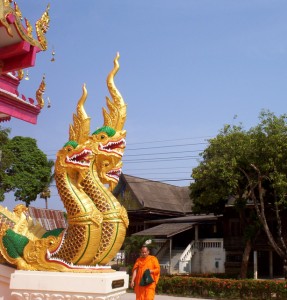
The Thai wat is the historic seed bed and contemporary canvas for the culture’s artistic expression and religious iconography. Thus if you wish to get a feel for Siamese culture, a visit to a temple or two is worth the effort. While the structures and imagery can seem almost nonsensical at times, all of its elements are a part of an ancient religious and cultural iconography that is distinctly Thai.
Mythic Monsters and Divine Beasts?
When you visit a wat, expect to see some bizarre creatures. More than simply decorative – although they are certainly that – each has a story or symbolic meaning behind it. Many of these beings are key figures in Thai mythology, but most stem from Hindu India origins, making their way to the area via several early Southeast Asian empires including Khmer, Srivijaya and Dvaravati.
The half man, half bird Garuda, is often found on temple pediments carrying the Hindu god Vishnu. Garuda is a character from the Ramakien who dies trying to rescue nang Sida, the hero’s wife, from the evil demon Tosekanth.
The Naga or serpent king is usually fashioned in pairs as stair-flanking balustrades. Sometimes nagas are inlaid with small bits of colored mirror and glitter wildly in the sun. This mythic snake was said to have protected the Buddha as he meditated during flooding rains by coiling its body underneath him to lift him above the torrent, and using its multitude of heads to form a protective cover.
Decorative chaofah, or sky tassels rise from either end of temple roof peaks and are often shaped like a bird’s head. It is said that chaofah serve the purpose of protecting sacred temple space from flying demons. Should a demon or evil spirit fall from the sky toward a wat, it would become impaled upon the point of the choafah and thus be unable to do harm to the religious community.
The best examples of the free-standing guardian giants called Yak or Yakshas can be seen in Bangkok’s Ratthanakhosin period temples such as Wat Prah Keaw, Wat Arun and Wat Pho. These mythic beings are thought of as benign nature spirits, despite their somewhat frightening appearance, and their specific function is to protect temples.
The half woman-half bird kinnari is often seen carved within eave brackets, or as part of other architectural ornamentation. They may also be found as free standing, guardian-like figurines. In Indian mythos, the kinnari are considered a subgroup of heavenly musicians.
Paintings and figurines of the earth mother Thorani wringing water from her hair is a common temple icon. Thorani is the goddess who witnessed the Buddha’s accumulated merit immediately prior to his enlightenment.
The bulbous-eyed Kala, typically seen over doorways, is a bit of a frightening character. Sporting horns, a lion’s nose and a wide, toothy grin, this ‘face of glory’ is used to chase away evil, in both Buddhist and Hindu mythology.
Other creatures and characters you may come across during a temple tour include hamsa, the Hindu god Brahma’s sacred goose; Hanuman, the beloved monkey hero of the Ramakien epic; the mythic makara, a sea creature with the body of a reptile that spouts a multi-headed snake from its mouth; Erawan, (Hindu Airavata) the three-headed elephant said to be born during the cosmic churning of the sea; and themphanom, graceful celestial beings or devas posed in worshipping gesture.
